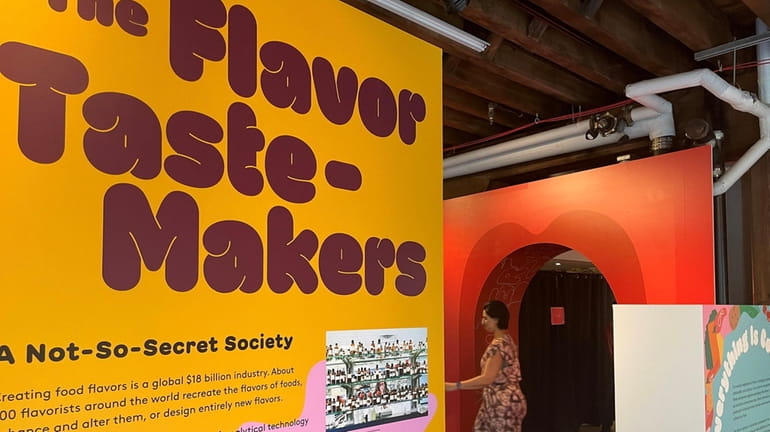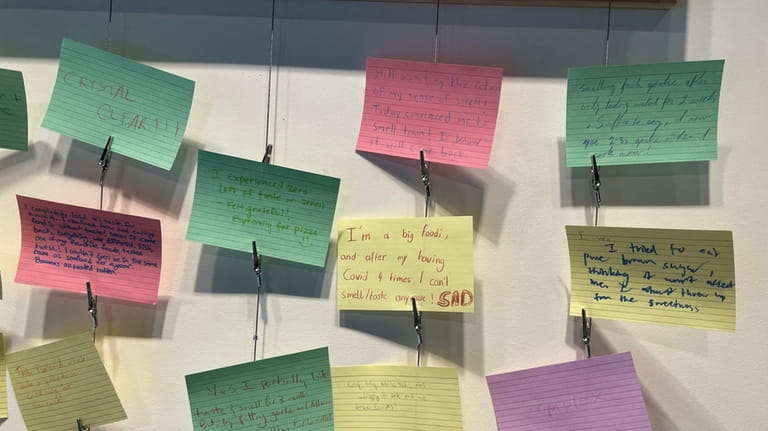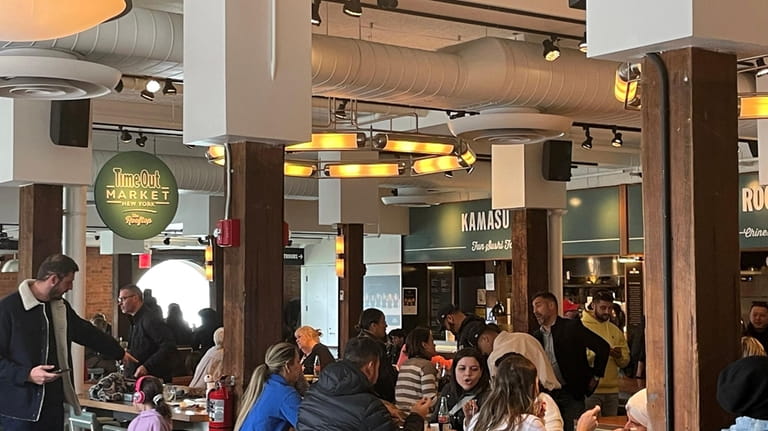The Museum of Food and Drink opens in Brooklyn

Many of the exhibits are interactive at the Museum of Food and Drink, which recently reopened in Brooklyn Credit: Newsday /Scott Vogel
There are a number of interesting aspects to “Flavor,” an exhibition at Brooklyn’s Museum of Food and Drink, making it worth a trip for anyone interested in the history and science of what we eat, which ought to be all of us. But for sheer impact, nothing beats “COVID & Flavor,” an interactive exhibit at show's end in which museum attendees are invited to write down how (and if) their senses of taste and smell were affected by Covid-19. Dozens of responses are tacked on the wall, and while a few read “Happily no” and “Only lost it for a little bit,” a number detail serious struggles, some ongoing. One, a self-described “big foodie” who contracted COVID four times “can’t smell/taste anymore. Sad.” Another lost both for two years, while a third is “still awaiting the return of my sense of smell.” Such plaintive messages are both a testament to the fragility of our senses and a vivid reminder of one of the sad legacies of the pandemic by a museum that has itself been deeply affected by it.
“We just opened up in our current space in February,” said a MOFAD ticket-seller on the second floor of the Empire Stores retail complex in the Dumbo neighborhood, handing me a receipt and small packet containing a tasting spoon and a few pieces of candy. “Please wait to eat those until you reach the Brainwave Bloom,” she added. “I promise it’s worth the wait.” With that, I passed through an archway shaped like a giant mouth and entered the exhibition.
Exhibits for the senses

Patrons are encouraged to reveal how Covid-19 affected their senses of taste and smell at the Museum of Food and Drink in Brooklyn. Credit: Newsday /Scott Vogel
The idea of a museum devoted to what it calls “the most universal aspect of human existence” is a terrific one, and after mounting several pop-up exhibitions in the 2010s, MOFAD found its first home in another part of Brooklyn, Williamsburg, in 2015. What followed were a number of inspired interactive exhibitions, including one tracing the history of Chinese American restaurants and another devoted to ceremonies and rituals around the world in which food and drink play a major role. For a time, MOFAD’s exhibitions were as popular with the public as they were with field-tripping schoolchildren, and there was much anticipation for a show on African Americans’ contributions to the nation’s table for which an opening was planned — in April 2020. Like many museums, MOFAD hastily canceled all exhibitions, shut its doors and went virtual, eventually going back to its roots and mounting pop-ups at various venues before acquiring a Dumbo lease last year.
“Flavor,” which — somewhat disappointingly — is not a new exhibition but an updated version of one from 2015, begins with the words TASTE and SMELL in big letters, which makes sense as these are the most important determiners of flavor, though not the only ones. We learn that sight and touch also play parts, as well as why smell memories are so powerful (something about the olfactory bulb’s connections to the amygdala and hippocampus), what umami is and why we crave it (it’s in breast milk and amniotic fluid) and more.
Then it’s on to the smell synthesizer, which not only emits aromas like coconut, popcorn and nail polish remover at the push of a button, but also asks patrons to depress multiple buttons at once, thereby creating hitherto unheard-of combos like smoky lavender, grassy banana and maple-tinged vomit. Later, I learned that gamma-hexalactone, a chemical commonly used to impart a coconutty smell odor to foods, can be harvested from green tea or tomatoes, not just coconuts, and that the scent of orange peel (decanal) can come from buckwheat and coriander.
MOFAD does a nice job of explaining such complex-sounding phenomena as chemesthetic sensations and retronasal olfaction, even as it nerds out on the tedium of extracting vanilla extract from the beans of an orchid, a nine-step process so difficult you’re almost grateful for vanillin, a substance first synthesized from pine bark and the first artificial flavor ever to be commercially produced, according to the museum. Elsewhere, MOFAD carefully avoids taking sides on the controversy surrounding such food additives, noting only that some folks see them as “a sign of an over-industrialized system producing ultra-processed foods,” while others believe that they're an “example of how humans have transformed food throughout our history.”

The Time Out Market, a food hall with dozens of vendors, sits directly under the Museum of Food and Drink in Brooklyn. Credit: Newsday /Scott Vogel
As directed, I waited to eat the Hershey’s Kiss in my flavor packet until I’d arrived at the Brainwave Bloom exhibit and put on a headset that tallied up my alpha, beta and theta waves. Thus did I discover I was theta-dominant, possibly indicating that the chocolate in my mouth was stirring up memories of some sort. “Does this flavor remind you of something?” asked the exhibit. Yes, I replied, it reminds me of how much Hershey’s Kisses taste like wax.
Still, the specter of COVID’s effects on flavor and its confounding ability to cancel some people’s TASTE and SMELL hangs heavily over the remounting of “Flavor.” Like the many still suffering from long COVID, MOFAD’s efforts at putting the pandemic behind it are ongoing. And for both, one hopes, recovery will come with time, patience and support from the rest of us, which ought to be reason enough to visit the museum.
And if not, there’s always the boisterous Time Out Market food hall on Empire Stores’ first level, which features dozens of vendors, offering diners innumerable chances to field test MOFAD’s theories of flavor.
The Museum of Food and Drink
55 Water St., 2nd Floor, Brooklyn
HOURS Wednesday through Sunday from noon to 5 p.m. The Time Out Market food hall is on the building’s first floor and open Sunday through Thursday from 8 a.m. to 10 p.m., Friday and Saturday from 8 a.m. to 11 p.m.
COST $15, $7 ages 5-13
MORE INFO 201-371-3550, mofad.org; 917-810-4855, timeoutmarket.com/newyork.

